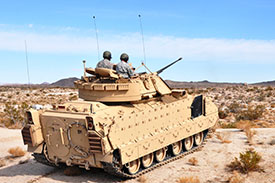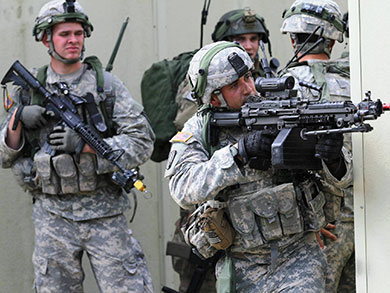- CAC Home
-
About CAC
-
CAC Senior Leaders
Commanding GeneralCombined Arms CenterLTG Milford H. Beagle Jr.Deputy to the
Commanding GeneralCombined Arms CenterMr. Gregg Thompson
Command Sergeant MajorCombined Arms CenterCSM Stephen Helton
Chief of StaffCombined Arms CenterCOL Brandon SmithCommand Chief Warrant OfficerCombined Arms CenterCW5 Carlos Terrones
Deputy
Commanding GeneralCAC ARNGBG Charles MorrisonDeputy
Commanding GeneralCAC USARVACANTDeputy Commanding General - EducationArmy UniversityBG David FoleyDeputy Commanding GeneralCAC - TrainingBG Jeremy WilsonDirectorMission Command Center
of ExcellenceCOL Bryan Babich
-
CAC Senior Leaders
-
Organizations
-
CAC HQ
-
CAC Subordinate Organizations
- The Army University (Army U)
- Combined Arms Center - Training (CAC-T)
-
Mission Command Center of Excellence (MCCoE)
- Leadership
- Mission Command Resources
- SharePoint
- Army Joint Support Team (AJST)
- Air Land Sea Space Application Center (ALSSA)
- Combined Arms Doctrine Directorate (CADD)
- Center for Army Leadership (CAL)
- Directorate of Training (DOT)
-
Force Modernization Proponent Center (FMPC)
- Command and Control Integration (C2I)
- Security Force Assistance Proponent (SFAP)
- Contact Us
- Peacekeeping & Stability Operations Institute (PKSOI)
-
Key Partner and Supporting Units
- » Fort Leavenworth Garrison
- » Presidio of Monterey Garrison
- » 902d Military Intelligence Group
- » Munson Army Health Center (MAHC)
- » Joint Center for International Security Force Assistance (JCISFA)
- » U.S. Disciplinary Barracks
- » Community Health Promotion Council (CHPC)
- » Red Team Education
- Contact Us
- Training & Doctrine Command (TRADOC)
- Mission Command Capability Development and Integration Directorate
- 15th MP Brigade
- Centers of Excellence
- Branch Schools
-
Non-Branch Schools
-
Command and General Staff College (CGSC)
- Leaders
- Mission & Vision
- Students
-
Command and General Staff School (CGSS)
- Inbound Class Information
- Department of Distance Education (DDE)
- Department of Command and Leadership (DCL)
- Department of Sustainment and Force Management (DSFM) (Previously DLRO)
- Satellite Campus Program
- Air Force Element (AFELM)
- Navy Element (NAVELM)
- Marine Corps Element (MCELM)
- International Military Student Division (IMSD)
- Contact Us
- School of Advanced Military Studies (SAMS)
- School for Command Preparation (SCP)
- Sergeants Major Academy (SGM-A)
- CGSC Degree Programs
- Registrar
- CGSC News Archive
- Contact CGSC
-
Warrant Officer Career College (WOCC)
- About USAWOCC
- Warrant Officer Program
- Warrant Officer Blackboard Enrollment
- Warrant Officer Courses
- Benefits, Pay, and financial Matters
- Fort Rucker Information
- News/Media
- Retirement/Transition Links
- Warrant Officer Career College Contact Information
- Center for the Army Profession and Leadership (CAPL)
- Western Hemisphere Institute for Security Cooperation (WHINSEC)
- SHARP Academy
- U.S. Army Sergeants Major Academy (USASMA)
- The U.S. Army Inspector General School (TIGS)
-
Command and General Staff College (CGSC)
-
CAC HQ
- References
- Products & Resources
Combat Training Center Directorate (CTCD)

Combat Training Center Directorate (CTCD) facilitates the validation, administration and integration of the Army’s Combat Training Center (CTC) program and its three maneuver CTCs (National Training Center, Joint Readiness Training Center and the Joint Multinational Readiness Center) and Mission Command Training Program worldwide deployable CTC.
Additionally, CTCD is responsible for ensuring CTC program requirements and modernization are linked to a viable resourcing strategy and CTC vision for the future. CTCD assists in programming and integrating DOD Training Transformation (that is, Joint National Training Capability) initiatives into the CTC program.
Army's Transition to Unified Land Operations
The CTC Program will lead the Army's transition to Unified Land Operations as described in ADP 3-0. Unified Land Operations are executed through Decisive Action by means of Army Core Competencies. The CTCs will accelerate a return to standards-based training and the pace of the Army’s transition to unified land operations (ULO) by challenging units and leaders to adapt to battlefield conditions, and by enhancing lethality and our ability to operate with our unified action partners (UAPs) and special operations forces (SOFs) across the range of military operations.
Success is defined as growing the next generation of adaptive Army leaders and providing relevant land forces for Army Force Generation requirements. Leaders and units are equally skilled and trained to standard in offense, defense and stability operations. The CTCs are the engine of change for collective training in the Army. What is trained and exercised at the CTCs drives training across the Army.
A Joint context will be provided at all the CTC training events as applicable to the unit's training objectives. Army CTCs will have a persistent capability to link to Joint National Training Capability. CTCs will provide the correct Joint context for training across all warfighting functions. Leaders, Soldiers and units will operate in the Joint environment and understand the interdependencies shared by the Army and others on the Joint team. The goal is to improve Joint interoperability by using the capabilities provided by an integrated Live, Virtual and Constructive training environment.
 Joint Multinational Readiness Center
Joint Multinational Readiness Center
